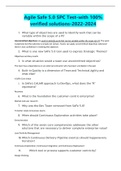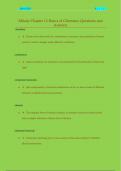SPC 1017 FSU MIDTERM, SPC 1017 ALL EXAM
QUESTIONS AND VERIFIED ANSWERS LATEST
UPDATED
Communication - ANSWER Any process in which people, through the use of
symbols, verbally and/or non-verbally, consciously or non-consciously,
intentionally or not intentionally, generate meanings (info, ideas, feelings, and
perceptions) w/in and across various contexts, cultures, channels, and media.
Elements in the communication model - ANSWER - senders/receivers
- message (V/NV), abstract and concrete
- channel: the senses, technology
- Feedback
- Noise: External (physical), Internal (psychological), semantic (physiological
noise)
- setting or context: intrapersonal/interpersonal
senders/receivers - ANSWER In communication settings, those who send and
receive messages
messages - ANSWER ideas and feelings that a sender/receiver wants to share
Nonverbal message - ANSWER All behaviors other than spoken words that
communicate messages and create shared meaning between people
EX- SMELL, DRESS, PITCH, ARTICULATION 67-93%
anything communicated w/o words (facial expressions, hand gestures, etc.)
Verbal message - ANSWER Expressing feelings, thoughts, or experiences with
words, either by speaking or writing
,Channels - ANSWER -the route travelled by a message
-it is the means a message uses to reach the sender-receivers
-THE SENSES-touch, taste, smell, TECHNOLOGY(thru text messages)
Feedback - ANSWER the response of the sender-receivers to each other
ex- TWEET LEADS TO MANY COMMENTS
-how you respond to something says a lot about a person
STRATEGIC FEEDBACK--ability to change messages in ways that will increase
your chances of obtaining your desired result
SENSORY ACUITY- paying attention to everything in the environment when you
talk to someone
External (physical) noise - ANSWER Interference with the message that comes
from the environment and keeps the message from being heard or understood.
Internal (psychological) noise - ANSWER Interference with the message that
occurs in the minds of the sender receivers when their thoughts or feelings are
focused on something other than the communication at hand.
Semantic (physiological noise) - ANSWER Interference w/ the message that is
caused by people's emotional reactions to words.
Setting - ANSWER Where the communication occurs
Context - ANSWER High context occurs when most of the meaning of the message
is either implied by the physical setting or is presumed to be part of the individuals
beliefs, values, and norms. It is considered low context when most of the info is in
the code or the message.
Communication as a Transaction - ANSWER 1) All communication has a past,
present, and future
2) Participation is continuous and simultaneous
3) All communication plays roles
Participation is continuous and simultaneous - ANSWER whether or not you are
,talking, you are actively involved in sending and receiving messages
cannot NOT communicate. When you're not even there you're participating in
communication--- did you leave the kitchen dirty or clean? Would I hire myself
based on facebook? SIGNING INTO CLASS OR NOT= MAYBE A BAD
STUDENT
Roles - ANSWER the parts you play or ways you behave with others
people who are really good at communication know when to play which roles.
-learning and how to play role is outcome of EDUCATION- how to be
BF/FRIEND/COUNCELOR/SPEAKER
-ORIENTATION LEADERS- TEACH YOU TO LEARN YOUR ROLE AS FSU
STUDENT
Ethical communication - ANSWER communication that is honest, fair, and
considerate of others' rights.
Whenever a message potentially can impact a reciever, ten ethics are a
consideration
Super mean coach. But every one of those players knew that he loved them.
NCA (National Communication Association) set of ethical principles and
guidelines.
Types of communication - ANSWER • Intrapersonal communication
• Interpersonal communication
• Small-group communication
• Public communication
Mass Communication
-intercultural communication
Intrapersonal communication - ANSWER Communication that occurs w/in you,
involves thoughts, feelings, and the way you look at yourself
, Interpersonal communication - ANSWER One person interacting w/ another on a
one-on-one basis. Often informal, unstructured setting
Small group communication - ANSWER small number of people meet to solve a
problem
-3-12 people solving a problem
OPTIMAL IS 5-7
Public communication - ANSWER - the sender-receiver sending a message to an
audience
public speaking
-you and an audience of 10 people (OR 200 PEOPLE= 200 SEPARATE SENDER
AND RECEIVERS
mass communication - ANSWER usually have delay, not anymore
ex-can tweet instead of write a letter now, so its faster now
-now have social media/cellphone and faster to find/communicate info
Intercultural communication - ANSWER communication between people of
different cultures
-all communication is in a culure, white on white is also intercultural bc have diff
experiences in their lives
Self concept- HOW DOES IT FORM? - ANSWER 1. reflected appraisals
2. social comparisons
3. self-perception
Reflected Appraisals - ANSWER messages you get about yourself from others




